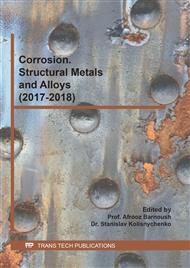[1]
Y. Ding, Y.J. Kim, J. Erlebacher, Nanoporous gold leaf: Ancient technology,, Adv. Mater. 16.21 (2004) 1897-(1900).
DOI: 10.1002/adma.200400792
Google Scholar
[2]
H.J. Qiu, J.Q. Wang, P. Liu,Y.Wang, M.W. Chen, Hierarchical nanoporous metal/metal-oxide composite by dealloying metallic glass for high-performance energy storage, Corros. Sci. 96 (2015) 196–202.
DOI: 10.1016/j.corsci.2015.04.003
Google Scholar
[3]
S.H. Kim, J.B, Choi, Q.N, Nguyen, J.M. Lee, S. Park, T.D. Chung, J.Y. Byun, Nanoporous platinum thin films synthesized by electrochemical dealloying for nonenzymatic glucose detection, Phys. Chem. Chem. Phys. 15 (2013) 5782-5787.
DOI: 10.1039/c2cp43097e
Google Scholar
[4]
Y. Ding, Dealloyed Nanoporous Metals for Catalysis, Reference Module in Materials Science and Materials Engineering, Dublin, (2016).
DOI: 10.1016/b978-0-12-803581-8.03801-7
Google Scholar
[5]
H.F. Guo, X.L. Yan, Y.Zhi, Z.W. Li, C.Wu, C.L. Zhao, J.Wang, Z.X.Yu, Y.Ding, W. He, et al. Nanostructuring gold wires as highly durable nanocatalysts for selective reduction of nitro compounds and azides with organosilanes, Nano Res. 8 (2015).
DOI: 10.1007/s12274-015-0703-4
Google Scholar
[6]
J. Gu,G.X. Lan, Y.Y. Jiang, Y.S. Xu, W. Zhu, C.H Jin, Y.W. Zhang, Shaped Pt-Ni nanocrystals with an ultrathin Pt-enriched shell derived from one-pot hydrothermal synthesis as active electrocatalysts for oxygen reduction, Nano Res. 8 (2015).
DOI: 10.1007/s12274-014-0632-7
Google Scholar
[7]
M. Hakamada,H. Nakano,T. Furukawa,M. Takahashi, M. Mabuchi, Hydrogen storage properties of nanoporous palladium fabricated by dealloying, Phys. Chem. C 114 (2010) 868–873.
DOI: 10.1021/jp909479m
Google Scholar
[8]
Q.Bai, Y. Wang, J. Zhang,Y. Ding, Z. Peng, Z. Zhang, Hierarchically nanoporous nickel-based actuators with giant reversible strain and ultrahigh work density, J Mater Chem C. 1 (2015) 45-52.
DOI: 10.1039/c5tc03048j
Google Scholar
[9]
T. Wang, D. Ren, Z. Huo, Z. Song, F. Jin, M. Chen, et al, Nanoporous nickel catalyst for selective hydrogenation of carbonates into formic acid in water, Green Chem, 3 (2016) 19.
DOI: 10.1039/c6gc02866g
Google Scholar
[10]
S.M Bhaway, Y.M Chen, Y. Guo, P. Tangvijitsakul, M.D. Soucek, M. Cakmak, Y. Zhu, B.D. Vogt, Hierarchical Electrospun and Cooperatively Assembled Nanoporous Ni/NiO/MnO x/Carbon Nanofiber Composites for Lithium Ion Battery Anodes, ACS applied materials & interfaces, 8 (2016).
DOI: 10.1021/acsami.6b05592
Google Scholar
[11]
J. Du, F. Cheng, M. Si, L. Liang, Z. Tao, J. Chen, Nanoporous ni-based catalysts for hydrogen generation fromhydrolysis of ammonia borane, Int J Hydrogen Energ, 38 (2016) 5768-5774.
DOI: 10.1016/j.ijhydene.2013.03.002
Google Scholar
[12]
J. Erlebacher, M.J. Aziz, A. Karma, N. Dimitrov, K. Sieradzki, Evolution of nanoporosity in dealloying, Nature, 410 (2001) 450.
DOI: 10.1038/35068529
Google Scholar
[13]
J. Erlebacher, K. Sieradzki, Pattern formation during dealloying, Scripta Mater, 49 (2003) 991–996.
DOI: 10.1016/s1359-6462(03)00471-8
Google Scholar
[14]
X. Wang, Z. Qi, C. Zhao, W. Wang, Z. Zhang, Influence of Alloy Composition and Dealloying Solution on the Formation and Microstructure of Monolithic Nanoporous Silver through Chemical Dealloying of Al−Ag Alloys, Phys. Chem. C 113 (2009).
DOI: 10.1021/jp902490u
Google Scholar
[15]
M. Raney, Catalysts From Alloys, Ind. Eng. Chem. 472 (1940) 1199-1203.
Google Scholar
[16]
Z. Qi, Z. Zhang, H. Jia, Y. Qu, G. Liu, X. Bian, Alloy composition dependence of formation of porous ni prepared by rapid solidification and chemical dealloying, J Alloy Compd. 472 (2009) 71-78.
DOI: 10.1016/j.jallcom.2008.04.017
Google Scholar
[17]
H. Zhang, Z. Wang, M. Yang, Q. Deng, The effect of an external magnetic field on the dealloying process of the Ni-Al alloy in alkaline solution, Phys. Chem. Chem. Phys. 19 (2017) 18167-18171.
DOI: 10.1039/c7cp03363j
Google Scholar
[18]
M. Hakamada, M. Mabuchi, Preparation of nanoporous Ni and Ni–Cu by dealloying of rolled Ni–Mn and Ni–Cu–Mn alloys, J Alloy Compd. 485 (2009) 583-587.
DOI: 10.1016/j.jallcom.2009.06.031
Google Scholar
[19]
S.G. Kim, A. Inoue, T. Masumoto, High mechanical strengths of Mg-Ni-Y and Mg-Cu-Y amorphous-alloys with significant supercooled liquid region, Mater Trans. 31 (1990) 929-934.
DOI: 10.2320/matertrans1989.31.929
Google Scholar
[20]
B. Baroux, Corrosion mechanisms in theory and practice, Crc Press, London. (2013).
Google Scholar
[21]
H.Y. Chi, Z.G. Yuan, W. Yan, M. Zuo, D.G. Zhao, H.R. Geng, Glass-forming ability, microhardness, corrosion resistance, and dealloying treatment of Mg60-xCu40Ndx alloy ribbons, Int. J. Miner. Metall. Mater. 24 (2017) 708–717.
DOI: 10.1007/s12613-017-1454-x
Google Scholar



